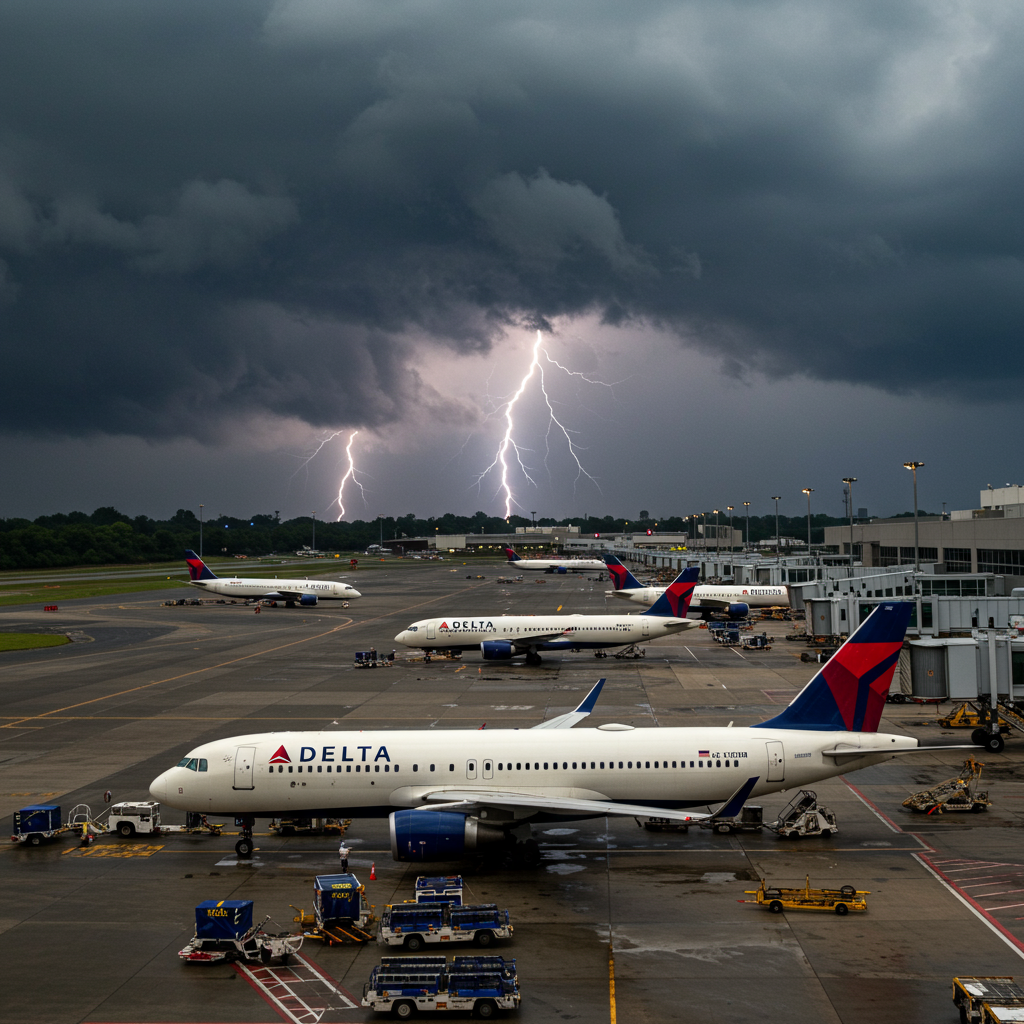Severe thunderstorms unleashed significant disruption across delta Air Lines’ operations at its crucial Hartsfield-Jackson Atlanta International Airport (ATL) hub on the evening of Friday, June 27, 2025. This major weather event, characterized by intense rain, lightning, hail, hazardous wind, and reports of microbursts, severely impacted one of the world’s busiest airports. Delta, which typically manages around 900 flights daily from Atlanta, faced cascading challenges. In response, the airline immediately shifted its focus to prioritizing customer care while implementing a complex operational recovery plan to restore its network safely and efficiently. The disruption led to hundreds of flight cancellations, extensive delays, and diversions just ahead of the busy Fourth of July holiday travel weekend, testing both the airline’s systems and traveler patience.
Anatomy of the Storm and Immediate Impact
The powerful storm system descended upon Atlanta with surprising intensity on Friday evening. Reports detailed quarter-inch hail and damaging winds alongside heavy rainfall and lightning. These severe conditions created unsafe operating environments at ATL, Delta’s largest hub. The Federal Aviation Administration (FAA) issued critical warnings and took immediate action.
The severity of the wind even necessitated the temporary evacuation of most air traffic controllers from the ATL control tower for safety reasons. While a small, dedicated crew remained to handle essential communications, this unavoidable measure slowed air traffic management. Flight operations were temporarily paused, and ground stops were implemented, preventing departures and arrivals. Furthermore, the hazardous conditions required Delta to proactively ground numerous aircraft during the peak of the storm to ensure the safety of passengers and crew. Over 90 Delta flights were forced to divert to other airports across the U.S. Southeast to ride out the weather.
Widespread Flight Disruptions Across the Network
The direct consequence of the severe weather striking Delta’s primary hub was widespread flight disruption felt throughout its system. By Friday evening, flight tracking data indicated over 1,000 flight delays and approximately 170 cancellations specifically at Hartsfield-Jackson Atlanta International Airport. The impact on passengers was immediate and frustrating.
Travelers experienced significant hold-ups. Departing flights from ATL faced delays ranging from 16 to 30 minutes on average by Friday evening. Incoming flights already airborne fared worse, with average delays stretching to 75 minutes. Due to the severe weather and subsequent operational challenges, the FAA enforced a restriction on landings at ATL, requiring all incoming flights to be held at their origin airports until after midnight EDT on Saturday. The disruptions continued to ripple throughout the weekend. By Saturday, the impact across Delta’s entire network was substantial, with the airline reporting 542 cancellations and 684 delays as teams worked tirelessly to recover from Friday night’s events in Atlanta. These figures underscored the sheer scale of the challenge presented by the storm hitting Delta’s most critical operational center right before a major holiday travel period.
Delta’s Safety-First Aircraft Inspections
Ensuring the safety of its fleet was Delta’s absolute paramount concern following the severe weather event. The hailstorm, in particular, raised potential issues regarding aircraft integrity. As a result, Delta initiated a comprehensive and time-sensitive inspection process immediately after the storm passed.
Maintenance teams began working around the clock to assess the condition of more than 100 Delta aircraft that had been exposed to the quarter-inch hail and high winds at ATL. The primary focus of these inspections was to check for any potential hail damage that could compromise the structural safety or airworthiness of the planes. This extensive inspection program was critical before these aircraft could be cleared to return to service. By Saturday morning, maintenance personnel had made significant progress, inspecting and clearing nearly all of the affected aircraft. This rapid turnaround was essential for Delta’s ability to begin repositioning its fleet and resuming a normal flight schedule, demonstrating the airline’s commitment to safety and operational efficiency even under duress.
Focusing on Operational Recovery and Customer Care
With the immediate storm having passed, Delta pivoted its full attention to two critical areas: operational recovery and dedicated customer care. Restoring the complex network of flights centered around the Atlanta hub required coordinated effort from multiple teams across the airline. Operational teams began the intricate process of repositioning aircraft scattered by the storm and diversions. Simultaneously, a major focus was placed on rescheduling flight crews, ensuring pilots and flight attendants were legally compliant with rest requirements before operating new flights.
Delta’s Chief Customer Experience Officer, Erik Snell, issued a message acknowledging the significant disruption. He offered a sincere apology to customers, stating that Delta understands travelers expect industry-leading reliability. Snell affirmed the company’s commitment to working “around the clock to make it right” for those impacted. He reiterated the extraordinary nature of the weather event and its widespread effects at the Atlanta hub. Across the organization, employees stepped up. Pilots, flight attendants, airport teams, and reservations specialists worked tirelessly to assist stranded and delayed passengers. Even headquarters volunteers were deployed to help manage the situation and provide support to travelers navigating the chaos.
Resources and Guidance for Affected Travelers
Navigating unexpected flight disruptions can be incredibly stressful for passengers. Recognizing this, Delta emphasized the resources available to help customers manage their altered travel plans. The most recommended tools for immediate assistance were the Fly Delta app and the airline’s official website, Delta.com.
These platforms provided the latest, real-time updates on flight statuses, crucial information regarding delays or cancellations, and access to flexible rebooking options. Customers were strongly encouraged to utilize these digital channels for the fastest service, as airport lines and phone wait times were likely to be extended given the scale of the disruption. Delta made efforts to offer flexible rebooking, allowing passengers to change their itineraries without penalty where eligible. For customers who incurred expenses directly related to the disruption, Delta also mentioned the availability of an expense reimbursement form. This guidance aimed to empower passengers with the tools and information needed to understand their options and take necessary steps to adjust their travel arrangements during the recovery period.
Anticipating Continued Challenges
Despite the intensive efforts underway, Delta cautioned that the full operational recovery following such a significant weather event impacting its main hub would take time. The complex tasks of inspecting aircraft, repositioning the fleet, and realigning crew schedules meant that the effects of the storm would likely continue to be felt beyond Friday night.
Delta anticipated several hundred more cancellations could occur over the weekend as teams worked through the backlog and the intricate process of restoring the network to full capacity. Delays were also expected to persist as operations gradually returned to normal. Therefore, Delta continued to advise all passengers traveling through Atlanta or on Delta flights impacted by the storm to check their flight status frequently before leaving for the airport. Staying informed via the Fly Delta app or Delta.com remained the best course of action for travelers during this dynamic recovery period. The airline reiterated its commitment to safely restoring its network and supporting customers as efficiently as possible through the ongoing challenges.
Frequently Asked Questions
What caused the major flight disruptions at Delta’s Atlanta hub?
The primary cause was a severe thunderstorm system that hit Hartsfield-Jackson Atlanta International Airport (ATL) on Friday, June 27, 2025. The storm brought intense rain, lightning, high winds, microbursts, and quarter-inch hail. These conditions were hazardous for operations, leading to ground stops, the temporary evacuation of the air traffic control tower, flight groundings, and diversions. The storm’s intensity necessitated safety checks like extensive aircraft inspections, which further contributed to delays and cancellations.
Where should Delta passengers find the latest updates and rebooking options?
Delta strongly advises affected passengers to use the Fly Delta app or visit Delta.com for the most current information regarding their flight status. These digital platforms provide real-time updates on delays and cancellations and offer options for flexible rebooking. In cases of significant disruption, these online resources are typically the fastest way for customers to find alternative flight arrangements or information about potential expense reimbursement.
How is Delta addressing the impact on passengers and operations following the storm?
Delta is focusing intensely on operational recovery and customer care. Maintenance teams worked overnight to inspect over 100 aircraft potentially damaged by hail, clearing most for service by Saturday morning. Operational teams are working around the clock to reposition aircraft and reschedule crews safely. Chief Customer Experience Officer Erik Snell issued an apology, affirming Delta’s commitment to making things right for affected customers. The airline is directing passengers to digital resources for updates and rebooking and mentioned an expense reimbursement process for eligible expenses.
Word Count Check: ~1180 words



